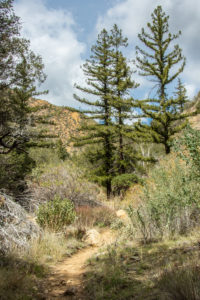
Bigcone Douglas-firs near the entrance to the Sespe Wilderness in Potrero John Canyon. Photo by Bryant Baker.
Pseudotsuga macrocarpa
The bigcone Douglas-fir (sometimes called bigcone-spruce) is an evergreen conifer found only in the mountains of southern California, from the San Rafael Mountains in Los Padres National Forest south to San Diego. Though not a true fir, the species gains its name by having the largest (by far) cones of all Douglas-firs, which were named after botanist David Douglas. The species was discovered in 1858 by an expedition who sighted the tree in San Felipe canyon near Julian in San Diego County. Early botanical writers were perplexed by the similarities between the bigcone and other Douglas-firs — the only differences being the bigcone’s extra-large cone size and growth habits.
The genus name Pseudotsuga means “false hemlock” due to their similarities to true hemlocks, whose genus name is Tsuga after the Japanese word for these trees. Douglas-firs grow throughout California, the Rockies, and other mountainous areas in the western U.S. However, the unique Bigcone Douglas-fir can only be found right here in the Coast, Transverse, and Peninsular Ranges of central and southern California.
Bigcone Douglas-fir is one of twelve “Management Indicator Species” for the Los Padres National Forest. It was selected for MIS status because they are believed to be a good indicator of the health of the ecosystem. They provide habitat for many rare wildlife species, including the California spotted owl, which depends on old-growth bigcone Douglas-firs and other conifers for survival.
Species Description
Bigcone Douglas-fir typically grows from 60-100 feet in height with a 2-5 foot trunk diameter and a collection of long branches giving it a sparse look. One of the largest big cone Douglas-fir trees on the Los Padres is located near Antimony Peak in Kern County, and measures more than 7 feet in diameter.
Young bigcone Douglas-firs look much like their Douglas-fir cousins, with smooth, gray bark. The can grow rapidly in sunny areas. Later in life, their bark becomes much redder than Douglas-firs, though they may be blackened by fire periodically. They also tend to grow in small patches or individually rather than sprawling stands like Douglas-firs. Because they are often the only conifers — and sometimes the only trees — on the local landscape covered with shrubs, they are ecologically-important to birds, small mammals, and insects.
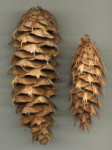
The cone of a bigcone Douglas-fir (left) compared to the cone of its cousin, the coast Douglas-fir (right). The pale-colored bracts are known to look like the rear end of a mouse sticking out between the scales. These are a defining feature of Douglas-fir species.
Cones are from 4-7 inches long (see photo to the right, comparing the much larger cone of the bigcone Douglas-fir with the smaller Douglas-fir cone), with larger, thicker scales than those of other Douglas-firs. The bracts protruding from cone’s scales are shorter, but similarly shaped as those of Douglas-firs. Their shape is often described as a mouse crawling into the space between scales. The seeds are actually so large and heavy that they are probably bird or mammal dispersed as the wing is too small to be effective for wind dispersal. Trees start producing seeds at about 20 years of age, and can live to be nearly 700 years old.
Range
The range of the bigcone Douglas-fir is about 135 miles from north to south and about 210 miles from east to west across southern California. Northern limits are near Mount Pinos in Kern County, and the headwaters of La Brea Creek in Santa Barbara County. Westernmost limits are Mission Canyon in the Santa Ynez Mountains, and Zaca Peak in the San Rafael Mountains.
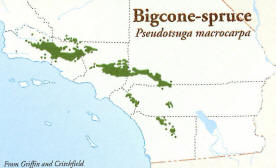 Older publications claimed that bigcone Douglas-fir grew in central Baja California, Mexico; a more recent publication verifies that it does not. The southern limit of the species is near the small mountain town of Julian, in San Diego County. The trees can grow under a wide variety of conditions. They can be found lower than 1,000 feet elevation to over 8,000 feet, and they grow in different orientation depending on altitudinal conditions and climatic influences.
Older publications claimed that bigcone Douglas-fir grew in central Baja California, Mexico; a more recent publication verifies that it does not. The southern limit of the species is near the small mountain town of Julian, in San Diego County. The trees can grow under a wide variety of conditions. They can be found lower than 1,000 feet elevation to over 8,000 feet, and they grow in different orientation depending on altitudinal conditions and climatic influences.
Bigcones and Wildfire
Bigcone Douglas-firs are one of the most fire resistant and fire adapted conifer species in the world, second only to redwoods in ability to recover from fire. Its thick bark and the presence of numerous buds on the upper side of the branches aid in its resistance — the trees will sprout from the burnt upper crown and the apparently dead tree becomes green again the following spring.
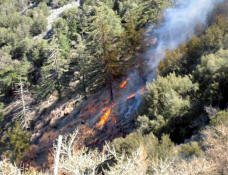 These adaptations suggest that the species has evolved to survive multiple fire events that sweep through these stands from the surrounding chaparral. A 2009 study conducted in the Los Padres National Forest looked at tree rings and fire scars on 85 bigcone Douglas-firs at 15 different sites. The earliest fire scars detected dated back to the year 1600, allowing scientists to reconstruct four centuries of fire history. The results indicated evidence of large fires in mountainous bigcone Douglas-fir stands every 50 years on average. The results of this study add to the overwhelming body of evidence that indicates the inevitability of large, infrequent, landscape-scale fires in southern California.
These adaptations suggest that the species has evolved to survive multiple fire events that sweep through these stands from the surrounding chaparral. A 2009 study conducted in the Los Padres National Forest looked at tree rings and fire scars on 85 bigcone Douglas-firs at 15 different sites. The earliest fire scars detected dated back to the year 1600, allowing scientists to reconstruct four centuries of fire history. The results indicated evidence of large fires in mountainous bigcone Douglas-fir stands every 50 years on average. The results of this study add to the overwhelming body of evidence that indicates the inevitability of large, infrequent, landscape-scale fires in southern California.
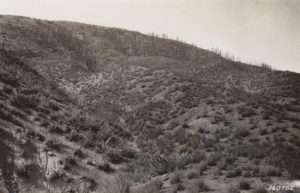
An bigcone Douglas-fir stand at the top of this ridge near Hwy 33 experienced high-intensity fire during the 1932 Matilija Fire. Photo courtesy UC Berkeley.
For example, several bigcone Douglas-fir stands experienced high intensity fire and mortality during the 1932 Matilija Fire in the Ojai backcountry. The Vegetation Type Mapping project in the 1930s captured some incredible photos of these stands within the fire scar just a few years after they burned.







